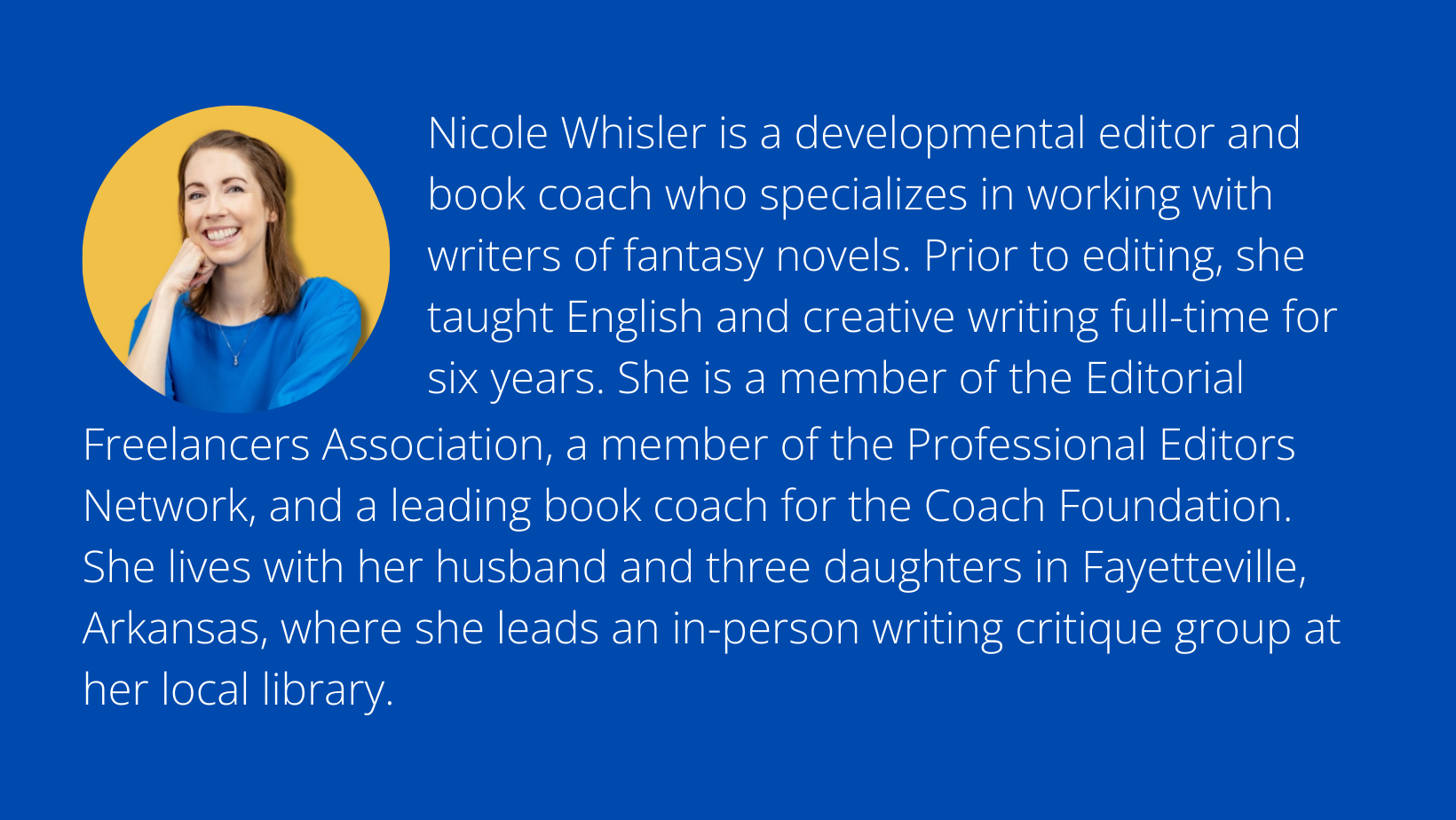Whisler Edits Blog

The Invisible Story You're Telling: How Subtext Shapes Fiction—and Life
Discover in this post …
how to avoid creating flat, surface-level scenes.
how to use subtext to deepen emotional resonance in your characters’ dialogue.
how to uncover the hidden subtext in your own life to understand—and even change—your results as a writer.
Are Your Scenes Falling Flat?
I’ve always been fascinated by what lies beneath the surface.
Was that person at the bookstore today actually happy, or were they smiling in an attempt to forget their pain? Is that singer as confident as she seems, or does she secretly panic at the idea of performing regularly in public? Is Patrick Rothfuss excited to release the third book in The Kingkiller Chronicle, or does he wish fame never crossed his doorstep and that his fans would leave him alone to do as he likes?
I don’t know the answers to these questions. I just like exploring them.

See, people present themselves in a certain way, but many of the most interesting items remain hidden unless the person chooses to reveal them. That’s why we like to build closer connections with people of our choosing (a.k.a. friends)—so we can get to know them beyond what they display on the surface.
The same applies to characters in books. If they come across as one-dimensional, if they always say what they mean, if they convey their mental desires, struggles, and goals perfectly as they speak with other characters … everything feels a little boring and unrealistic.
That’s where subtext comes in. In dialogue, which is the area I’m discussing today, subtext is what’s implied without being explicitly stated. It helps your characters—and your story—come alive!
Below, let’s examine not only how subtext in dialogue drives fiction and allows us to deepen a reader’s emotional connection with our characters, but also how it drives the underlying stories we tell ourselves as writers—stories that play an essential role in our own successes and failures.
Ready? Let’s dive in.
How Subtext in Dialogue Shapes Fiction
In terms of dialogue, subtext is what’s implied in a conversation but not spoken aloud. It refers to the hidden motives, thoughts, and inner life within a character—items that are felt (either by the point-of-view character or the person they’re speaking with) but left unsaid.
When Wesley says “As you wish” to Buttercup in The Princess Bride, Buttercup

eventually learns that what he really means is “I love you.” Were he to state his feelings outright, this part of the story would lose some of its emotional depth and resonance. Declaring your love for someone is quite “on the nose” and (in fiction, anyway) is best saved for moments that are already layered with complexity. Rather than saying “I love you” after a simple romantic dinner, a character might say it when he fears he’ll never see the love interest again. Or just after she has said something terribly hurtful to him. Or when the character knows she’ll never say it back.
The ultimate danger related to this topic, then, is to write scenes that are too simple, too straightforward—scenes that lack complexity or depth. Scenes that fall flat.
So what can you do to avoid oversimplicity? As I’ve mentioned above, what’s said in dialogue isn’t usually a true reflection of a character’s inner desires and thoughts. Dialogue is only a piece of your character and should be treated as such.
To introduce some subtext in your conversations between characters, you can contrast what’s said out loud with the character’s internal state (which means it’s essential we know our characters well and understand what’s motivating them, since subtext is all about desire). Here are a few ways to do that:
Have one character lie to another. Make sure the lie carries some emotional weight behind it. If readers understand a point-of-view character’s motivation for lying and can justify it, they can still attach to that character and root for them. And if someone lies to your point-of-view character, that’s interesting as well because it brings up a range of new issues: does your POV character know they’re being lied to or not? And if they do, what will they do about it? In Breaking Bad, when Walter insists he’s doing everything “for the family,” the audience knows he’s really feeding his pride and hunger for power. His words and his motives diverge, and that gap between them acts as the subtext that keeps viewers hooked.
Have characters misunderstand each other. This is a plot device that can annoy readers when it’s overdone or when it’s used for no other reason than to draw out the story, but when it furthers a character arc or leads to a satisfying twist, a misunderstanding can work well. In Pride and Prejudice, Elizabeth and Darcy’s early exchanges are loaded with misinterpretation. Each believes the other arrogant or disingenuous, but what’s really at play are pride, insecurity, and attraction—none of which they say outright. This subtext creates strong tension anytime the two of them are on the page together.
Have characters hedge or refuse to answer each other. This can stir up an intriguing sense of mystery or distrust for readers or other characters because it makes them ask, “What’s the character hiding?” It also brings out elements of that character’s personality that may have been previously concealed. In The Hunger Games, when Katniss is asked about her feelings for Peeta in interviews, she skirts the truth to protect them both. Her careful half-truths reveal her fear and strategic thinking more clearly than a full confession ever could.
Even in quieter scenes, subtext gives dialogue energy. A daughter saying, “You’re working late again?” might sound like a casual question, but if we sense her disappointment beneath it, we suddenly feel the emotional undercurrent of the relationship.
Whether it’s a lie, a misunderstanding, or an avoidance, the most powerful dialogue often lives in what isn’t said. That tension between words and meaning is what pulls readers deeper into your characters’ inner worlds—and keeps them turning pages.
Here’s an activity to help you introduce some subtext in your own work in progress to test how it might alter one of your scenes:
ACTIVITY:
Choose a scene and have one character lie to another when in your initial draft, they told the truth. Does anything change for those characters and their story arcs? Is it a minor internal struggle, or does the change put your characters on a new path entirely? Readers love change, so feel free to experiment! Just don’t forget your original vision for your project. If you end up altering the direction of your story, make sure it’s for reasons you love.
How You Can Change Your Writing Life through Subtext
Now that we’ve covered how to introduce some subtext on the page to add life to our scenes, let’s move on to how subtext not only drives our characters but also drives us personally in our day-to-day writing lives.
In fiction, subtext is what’s unsaid. It’s the hidden emotions and motives that shape how characters speak and act. But subtext isn’t just for stories.

We have subtext in real life too—the quiet beliefs and fears whispering beneath our words and choices. Let’s refer to this real-life subtext as “a person’s inner thought life—what they’re telling themselves internally that leads to their results.”
As a writer, you hold incredible power. Too many writers don’t realize this. You’re your own boss. You call the shots. You decide when you write. When you stop. When you want to release a book. How you want to release it. How many books you want to write. Which readers you want to connect with.
The list goes on.
Unfortunately, all too often I’ve seen the subtext—what writers are telling themselves beneath the surface—impact them in a negative way. Writers often give every excuse under the sun about why they can’t succeed as a writer:
“Now isn’t the right time.”
“I’ve lost my muse.”
“I’m worried I’ll never measure up to my favorite authors.”
“I want to get healthier before I start writing.”
"I’m busy.”
“I have a family. Maybe when my kids are in college I’ll write again.”
“I’m not in the right headspace.”
Let me be clear: the above items are not intrinsically negative things, nor are they necessarily untruths. They’re simply circumstances and/or stories you’re telling yourself. But while some of these statements can be true and simple, with no subtext at all, in other cases, I’ve seen subtext rear its ugly head in a writer’s life in a way that contrasts the results the writer says they want. For example, a writer who says “I don’t have time” might actually be covering up the thought, I’m afraid I might fail. A writer who says “I’m not in the right headspace” might be hiding their real concern: What if my writing isn’t good enough?
(As a side note, one of the best ways to determine whether the story your brain is telling you is actually true is to ask yourself, “Do I love my reasons for this?” For example, claiming you’re busy and that it’s impossible for you to write at all, which is likely not true or preferable, is very different from making an active choice not to write for the next several months because you’re fully focused on something else—and you love your reasons for that.)
So for those of us who want to write, but our underlying thoughts are slowing us down, what can we do about this?
First, we can acknowledge that it’s not hopeless. We can take action and write past our fears, but the first step is one that many writers don’t take: before we do anything else, we must recognize our inner subtext for what it is. We have to stop accepting all our thoughts as truths, especially when they’re detrimental to our pursuit of living the writing life we want.
Don't allow your subtext to quietly steer your writing journey. When you decide to let your busy lifestyle keep you from making progress on your story, or when you think you need to wait for the muse to return, or when you serve your family daily but never pay attention to your own needs … you decide your own fate.
But on the flip side, what if you examined what’s possible in your own life? What if you could be both a writer and a mother? A writer and a grad student? A writer who becomes famous not overnight, but by plugging away one day at a time, a few words at a time?

When you allow possibility to overshadow risk (because those negative thoughts are ultimately about fear and what-ifs), you give yourself permission to take action. You stop believing the stories your brain feeds you and focus on results-driven activities instead.
I’ve seen it time and time again: growing in your own self-awareness—and making new decisions based on those insights—is the path to meeting your writing goals. That’s how you’ll write “The End,” share your story with the world, and move on to your next project.
To start training yourself to focus on thoughts that serve you as a writer, try this activity, which is meant for those who want to write but aren’t building consistency:
ACTIVITY:
Identify the story your brain is telling you (see examples listed above to help). Once you’ve done so, ask yourself, “Is this true, and does this serve me?” If your answer is no, journal about your doubts, worries, and what-ifs until you’re clear on what’s coming up for you. Include the stakes of what could happen if you continue to move forward according to that thought—and what thought you’d like to focus on instead. Then put that new thought somewhere you’ll see it every day! Writing it on your bathroom mirror, jotting it down on a note card at your writing station, or attaching a post-it to your computer are all good options.
I hope today’s post inspires you to heighten the dramatic tension in your stories and sharpen your characters’ motivations. More than that, I hope it encourages you to pause and reflect on the results you’re seeing in your own writing life—so you can celebrate how far you’ve come or make thoughtful adjustments where needed. If this post sparks a breakthrough in your writing or mindset, I’d love to hear about it. Feel free to email me at [email protected] and share your thoughts!
Do you want to learn how to write a story that makes your target readers stand up and cheer? If you’d like support from A to Z (from brainstorming to drafting to revising to publication), book a Discovery Call with me to see if you’re a good fit to join my book coaching program, Fantasy Footsteps: Road to Publication. And if you haven’t done so already, grab your Free Guide on how to hook readers from your story’s start!


